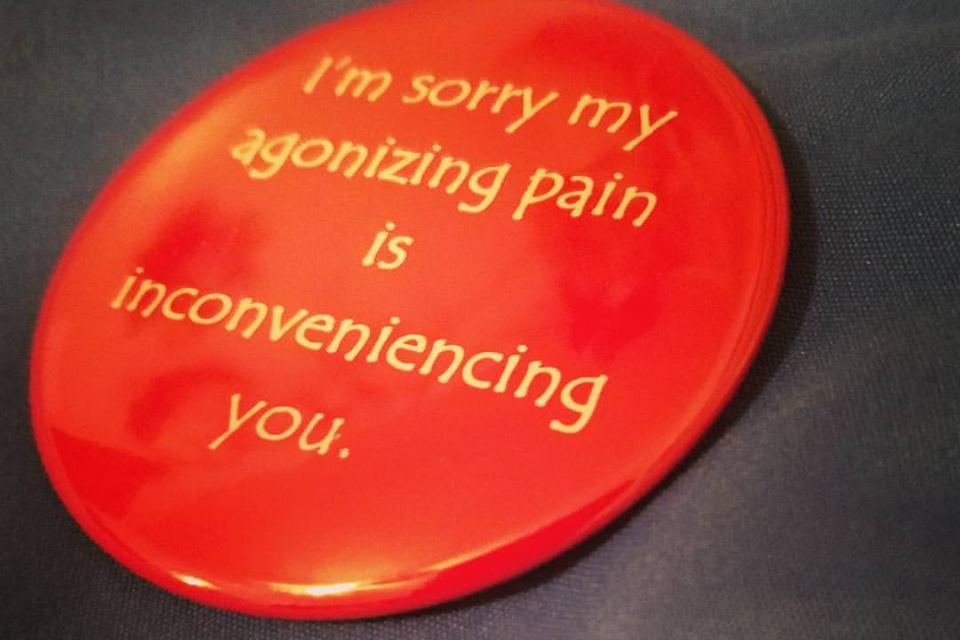For Pain Awareness Month, I’m offering an AMA about my experiences with pain.
Ask any question you may have regarding the pain I experience, the physical disabilities that cause it, or how I use kink to manage it, and I’ll answer honestly.
Some of the conditions I have that cause pain are:
- hypermobile Ehlers-Danlos syndrome (hEDS)
- irritable bowel syndrome with constipation (IBS-C)
- mast cell activation syndrome (MCAS)
- migraine (multiple types)
- multilevel degenerative cervical disc bulging and spondylosis
- osteoarthritis (OA)
- polycystic ovarian syndrome (PCOS)
- pudendal neuralgia (PN)
- temporomandibular joint dysfunction (TMJ)
Additionally, I had my second ketamine infusion for “acute chronic pain” on September 7th. I keep getting told folks have a lot of questions about ketamine infusions (and yes, it also helps with my depression; I’m bipolar), so if you want, AMA and I’ll try to answer.
Questions I’ve received so far, and their answers.
How *do* you use kink to manage it? 😉 Really am curious about specific strategies, something more than the generalities a lot of us are aware of.
When I have localized deep tissue pain, I like to receive thudding/hard/deep impact play (but not on the site where the localized pain is). When I have a flare from MCAS that manifests as full body pruritis, I like to receive impact play that stings. I also find utensils such as the Wartenberg pinwheel to be very useful in this situation. When I have a TMJ flare, I like to turn that into a challenge to keep my mouth open (even if it only opens half an inch). When I’m in so much pain that I can’t motivate myself to do anything, I find that I can motivate myself to do things if someone I trust turns what I need to get done into a D/s scene (where I’m the s). When I want to be sexual or kinky but find that I can’t stand to be touched for reasons of pain and its related symptoms (such as fatigue, numbness, pins and needles, etc.), I find that going into a D/s scene as the D is exactly what I need. Often, it results in the ability (and desire) to be touched.
Which conditions have generalized pain symptoms, versus specific areas of the body? Was it harder for those ones to get diagnosed? Do some of these conditions often come paired together? Have you learned anything interesting from having them? (feel free to answer any/none)
1. hEDS and MCAS provide generalized pain and the others provide localized pain. However, hEDS can also (and does) manifest as localized acute pain — and those localizations can be pretty much anywhere. It doesn’t stick with just the affected joint because of how pain can refer and because of how the body is interconnected (for example, something with the spine can be felt in the foot; something with the jaw can be felt in the shoulder, etc.).
2. hEDS is my primary diagnosis. All the other conditions often come with or can happen as a side effect of hEDS. That makes them all co-occurring conditions. The pudendal neuralgia is (most likely) present because of my SI joint’s 20+ years of instability. The SI joint impacts the hip, which impact the pelvic muscles, which impacts the pudendal nerve, and then boom, pudendal neuralgia.
3. I have learned that I’m not alone. While that’s maybe not the most interesting thing, it’s been the most important.
When managing different kinds of pain, do you find that different stimuli, such as heat or cold, work better (or worse) for different types of pain, or for pain in different places in the body?
I do! For example, the pain in my groin is nerve pain. I find that responds best to ice, as does the pain in my left hip when I’ve “overdone” activities. Heating my hip and groin always make that pain worse. I can’t ice my hands when they hurt because it makes the pain worse, but heat on my hands feels good. Heating my neck works, particularly when the muscles are spasming. When I can stomach the skin pain, ice on my face (for migraines and TMJ) can help far more than heat. It’s taken me years to figure out when I need to ice and when I need to heat — and I don’t always get it right!
I also have IBS! What has worked well for you in managing that? I’ve done daily fiber pills, daily coffee (which sometimes helps), but mostly just suffering through it
Daily coffee helps me, sometimes, as does making sure I stay hydrated. But I quickly go from constipated to diarrhea and both can happen from coffee and overhydration. I don’t think there’s a concrete formula for balance with my body; I seem to either be backed up or overflowing. I wish I could offer more than that to you!
Is it [being on ketamine] like being on drugs in the same way that using LSD or MDMA etc is?
I have a hard time vocalizing my thoughts and keeping track of what I’m saying during the first 3 hours or so of the infusion. (It’s a 4-hour infusion.) If I close my eyes, the “visuals” are intense, especially when I’m listening to music. With my eyes open, I can’t focus on anything and I constantly feel like everything is sliding — but I don’t have visual hallucinations of what’s in the room. I also don’t have auditory hallucinations. During the infusion, I lose all of the pain in my body and almost feel numb. And I feel very, very connected with “life” and what it means to be alive. It’s very soothing.
Are you going to keep doing them?
Definitely. They really help with the pain.
how long does the relief of the infusion last? asking for a loved one.
Full relief lasts for two weeks for me! But it varies for each person.
How do you feel now?
Unfortunately, the second infusion did nothing for the pain. However, I’m in a wonderful, upbeat mood, so that’s something.
How long do you find it eases your pain for? I know that for depression it works for 2-4 weeks, and I’m wondring if pain is similar
I had full pain relief for about 2 weeks before it started creeping back.
Hi, I have q’s I was too nervous to ask the pain specialist about it when it came up as a potential treatment option: how long did the immediate effect last? Did you have any negative side effects? Where was it administered (surgery or home?) and how (method of administering)?
For me, the pain relief stops as soon as the infusion stops, then comes back about a day later. That full relief lasted about two weeks. I had no negative side effects at all. I have mine done in a hospital via an IV in my arm. The infusion itself lasts four hours.


